Seasonal Hydrological Loading in Southern Tibet Detected by Joint Analysis of GPS and GRACE
Abstract
:1. Introduction
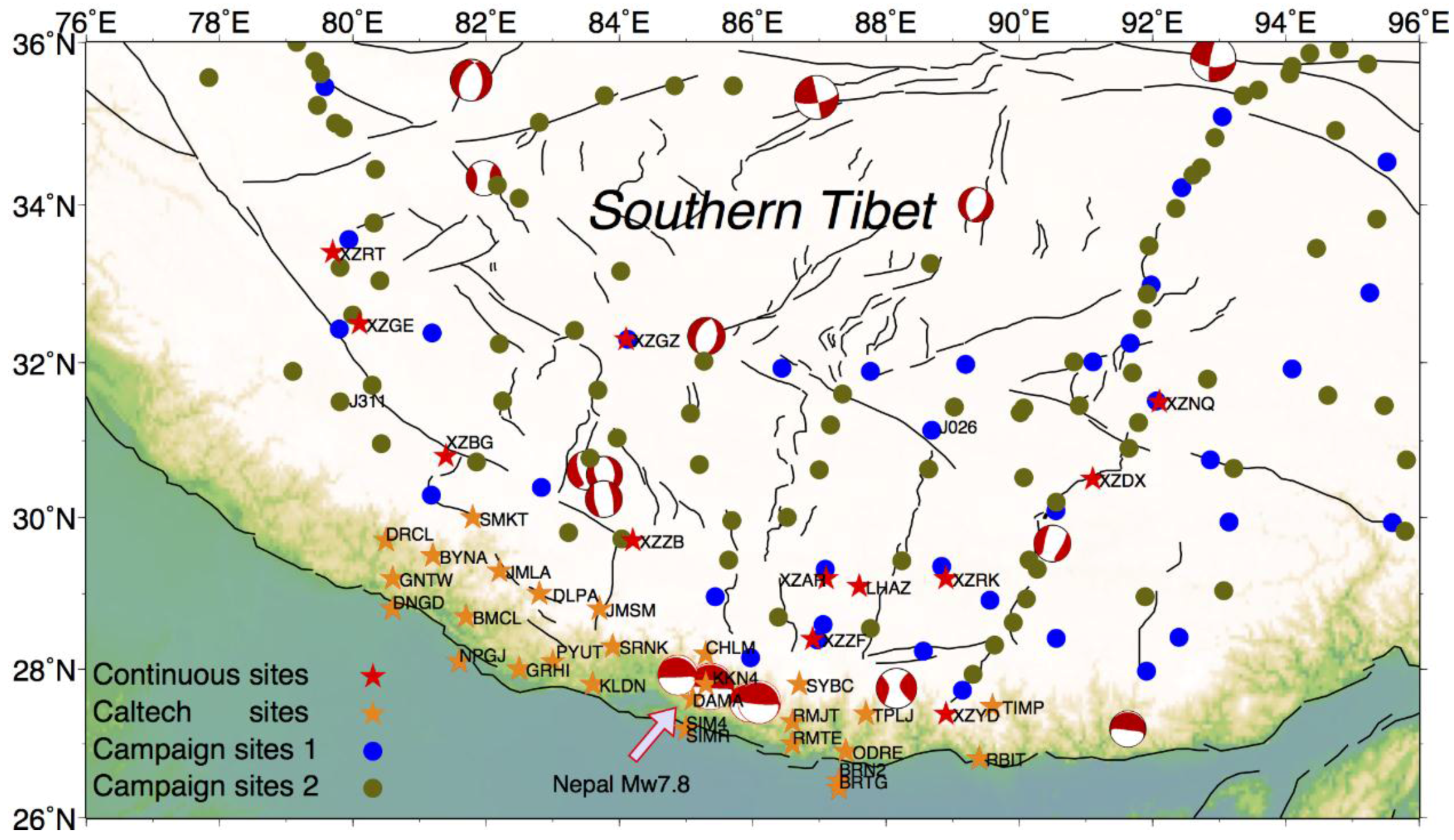
2. Geodetic Measurements
2.1. Continuous and Campaign GPS Observations and Data Processing
| Stations | Number | Time Span | Organization |
|---|---|---|---|
| Continuous stations | 1 | 1998–2014 | CMONOC I |
| 13 | 2011–2015 | CMONOC II | |
| 28 | 1999–2015 | Caltech | |
| Campaign stations | 36 | 1999–2013 | CMONOC I |
| 87 | 2009–2013 | CMONOC II |
2.2. Analysis and Processing of GRACE Measurements
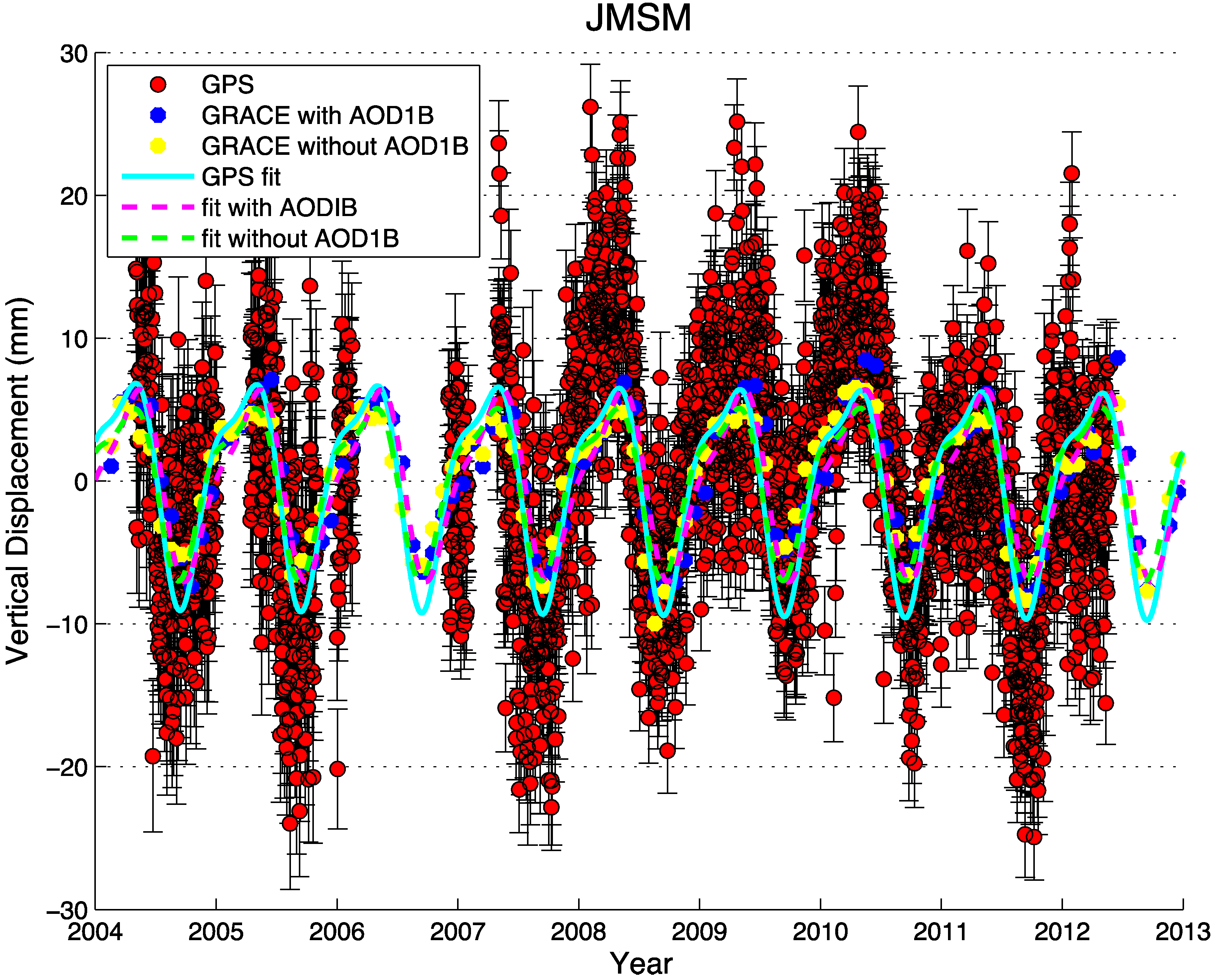
2.3. Comparison between Seasonal Variations in GPS and GRACE
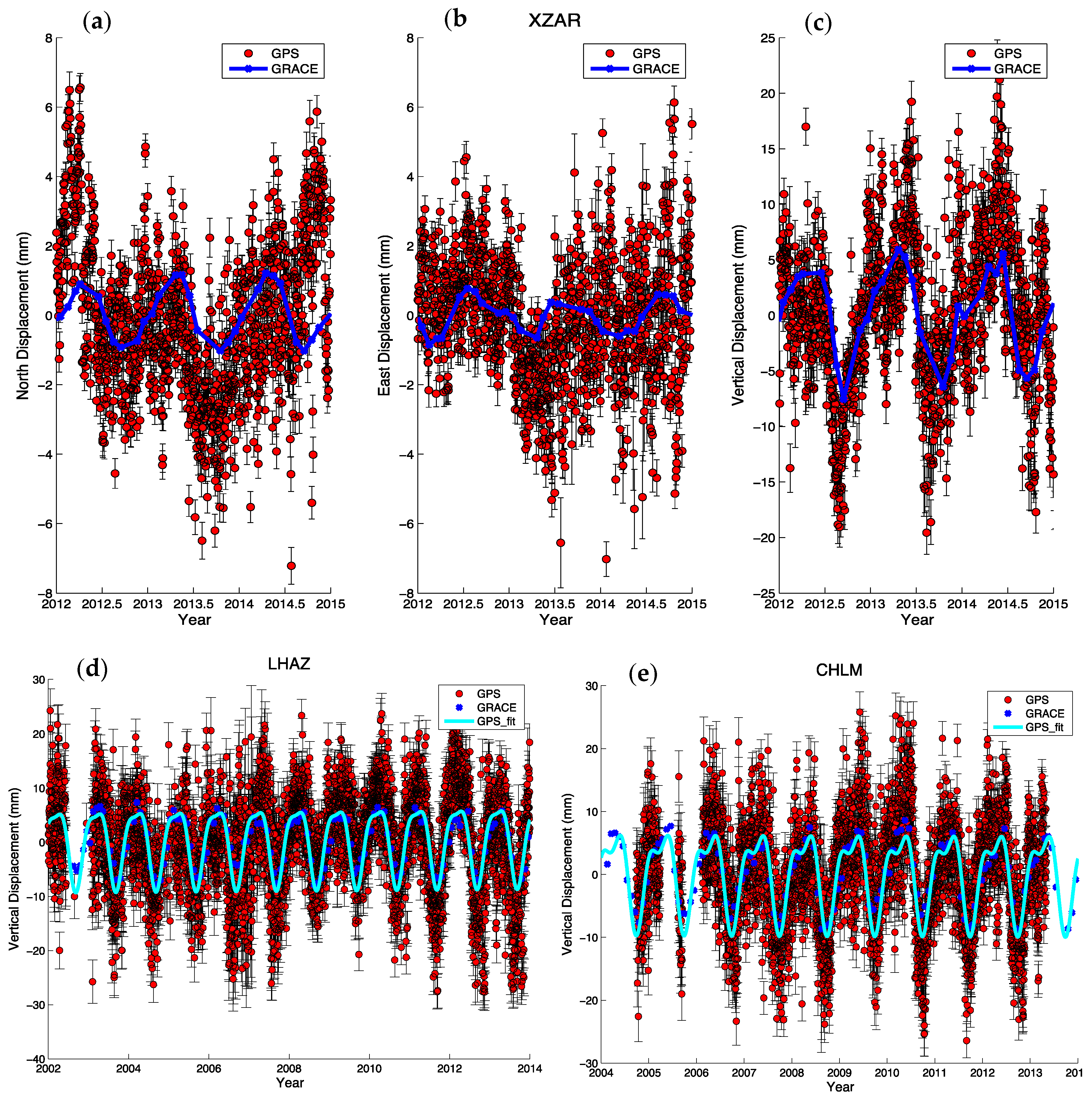
2.4. Modeling of Seasonal Variations
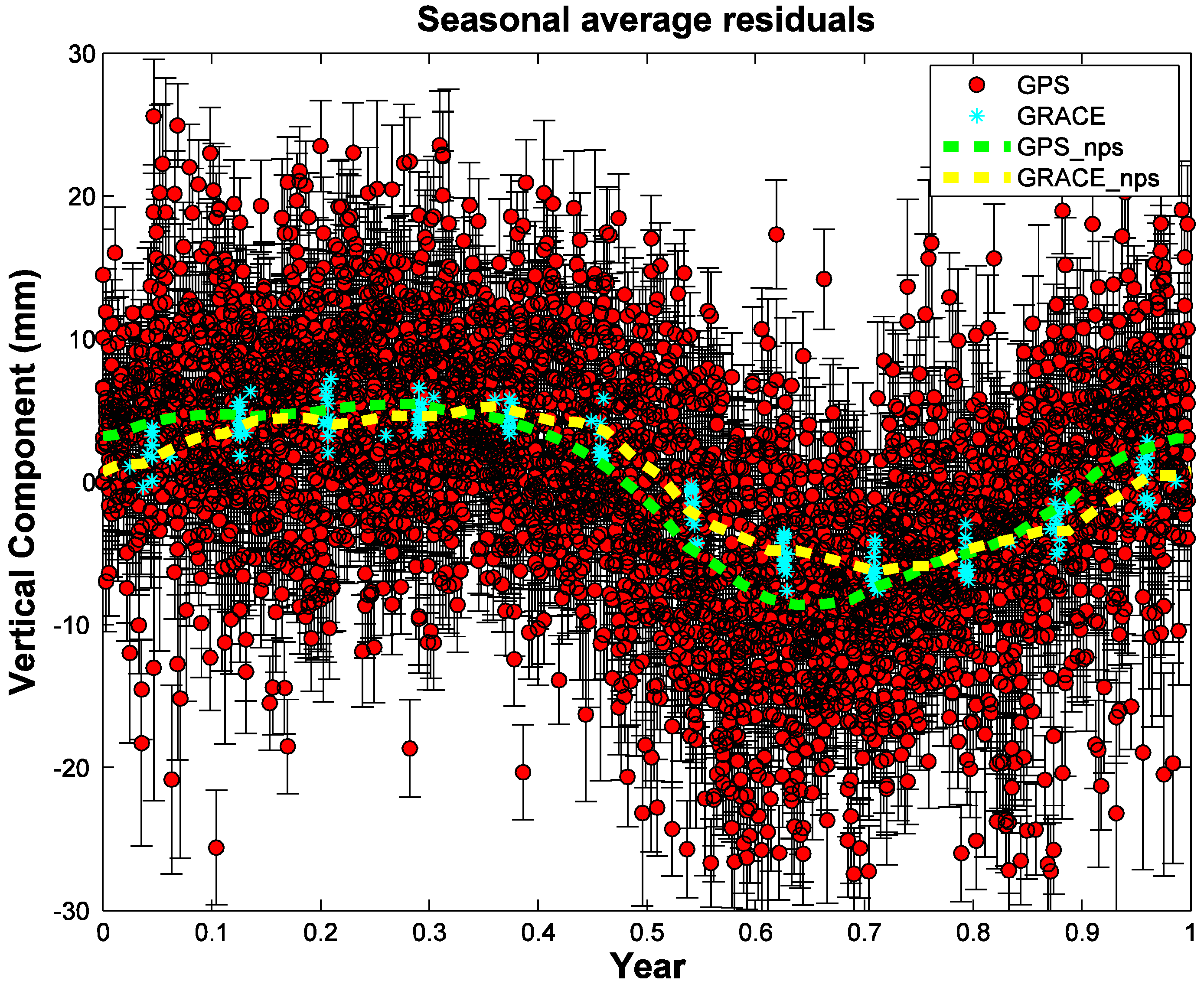
3. Results and Discussion
3.1. Correcting Hydrological Loading Deformation by GRACE Data
3.1.1. Vertical Deformation

3.1.2. Horizontal Deformation
3.2. Seasonal Variations in Campaign GPS Sites
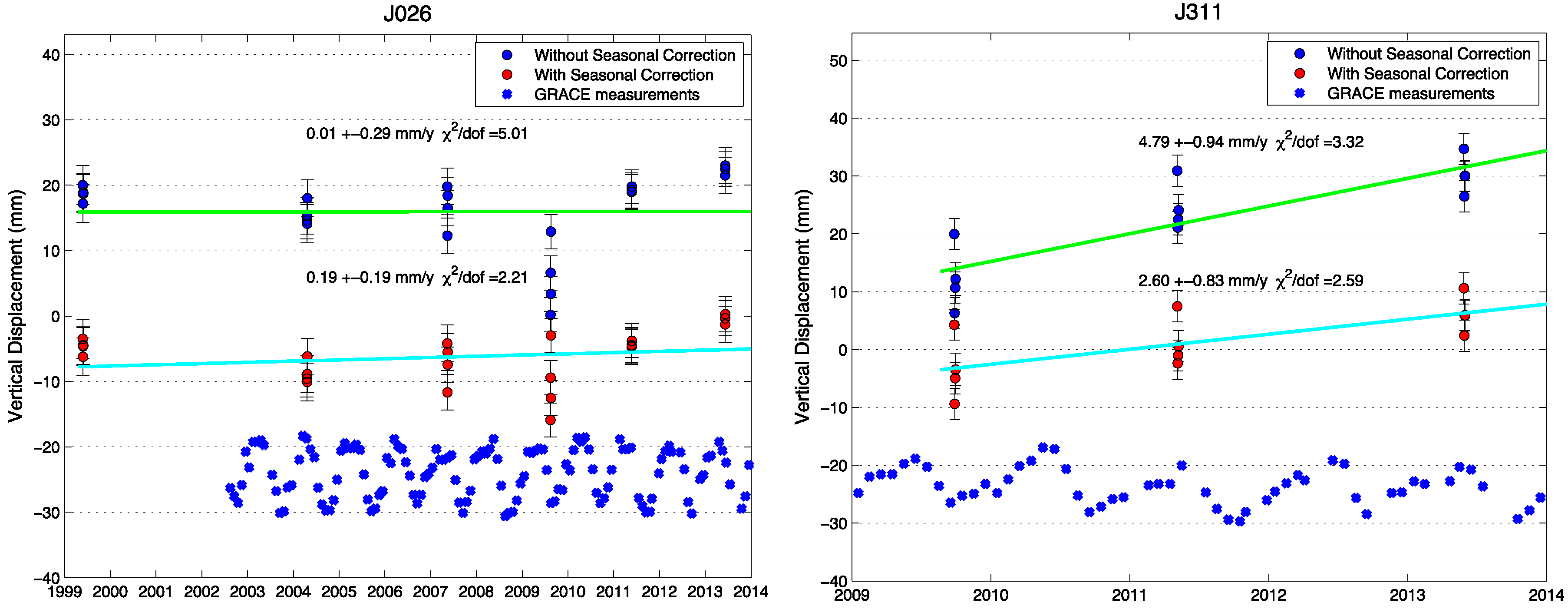
3.3. Impacts on Post-Earthquake Measurements for the 2015 Nepal Earthquake
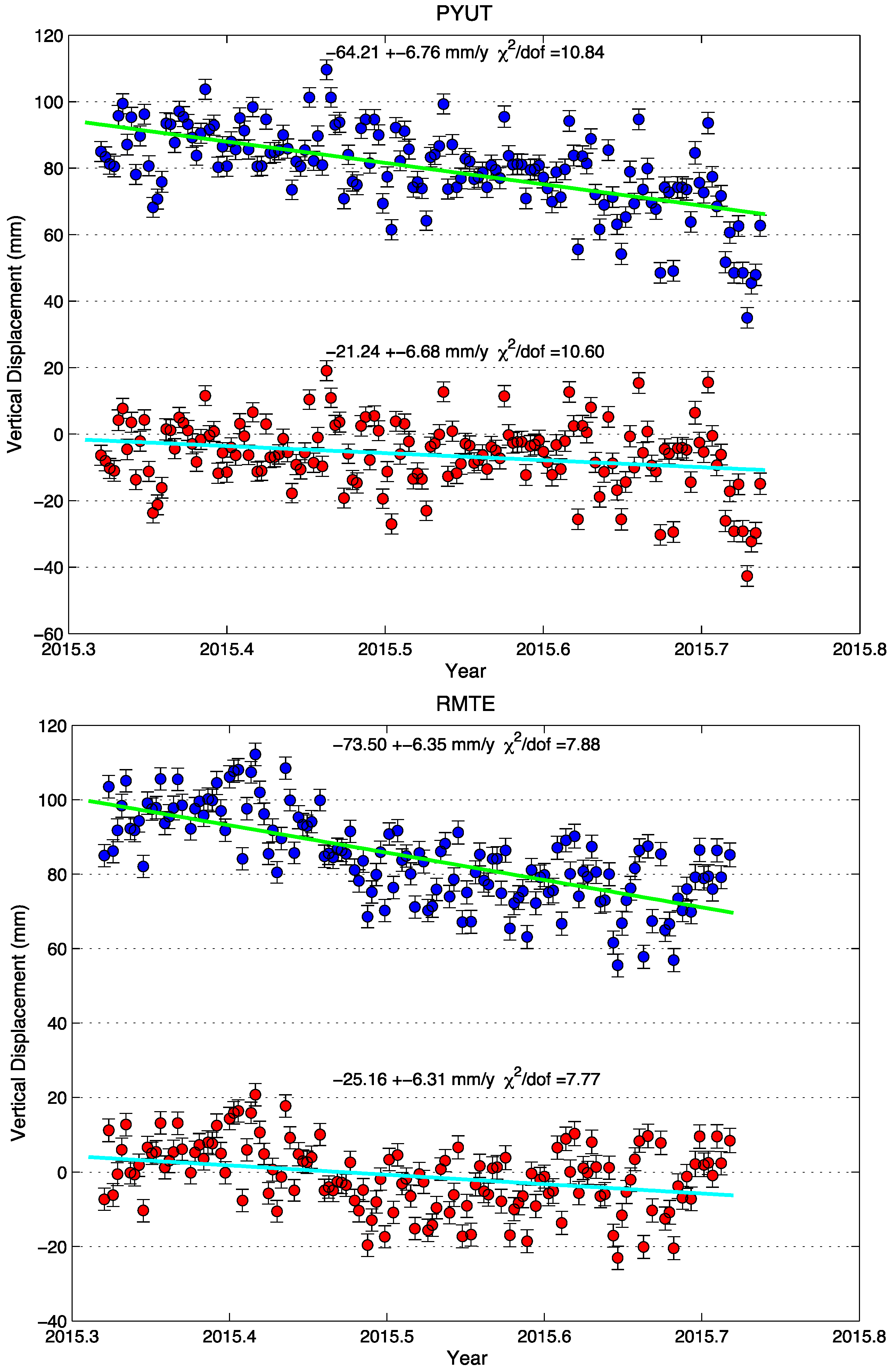
4. Conclusions
Acknowledgments
Author Contributions
Conflicts of Interest
References
- Molnar, P.; Tapponnier, P. Cenozoic tectonics of Asia: Effects of a continental collision. Science 1975, 189, 419–426. [Google Scholar] [CrossRef] [PubMed]
- Avouac, J.P.; Tapponnier, P. Kinematic model of active deformation in Asia. Geophys. Res. Lett. 1993, 20, 895–898. [Google Scholar] [CrossRef]
- Bilham, R.; Larson, K.; Freymueller, J. Project Idylhim members. GPS measurements of present day convergence rates in the Nepal Himalaya. Nature 1997, 336, 61–64. [Google Scholar] [CrossRef]
- Avouac, J.P. Mountain building, erosion, and the seismic cycle in the Nepal Himalaya. Adv. Geophys. 2003, 46, 1–80. [Google Scholar]
- Gupta, H.K.; Gahalaut, V.K. Seismotectonics and large earthquake generation in the Himalayan region. Gondwana Res. 2014, 25, 204–213. [Google Scholar] [CrossRef]
- Avouac, J.P.; Meng, L.; Wei, S.; Wang, T.; Ampuero, J.P. Lower edge of locked Main Himalayan Thrust unzipped by the 2015 Gorkha earthquake. Nat. Geosci. 2015, 8, 708–711. [Google Scholar] [CrossRef]
- Global CMT Catalog Search. Available online: http://www.globalcmt.org/cgi-bin/globalcmt-cgi-bin/CMT4/form?itype=ymd&yr=1976&mo=1&day=1&otype=ymd&oyr=2015&omo=5&oday=30&jyr=1976&jday=1&ojyr=1976&ojday=1&nday=1&lmw=7&umw=10&lms=0&ums=10&lmb=0&umb=10&llat=26&ulat=76&llon=76&ulon=96&lhd=0&uhd=1000<s=-9999&uts=9999&lpe1=0&upe1=90&lpe2=0&upe2=90&list=0 (accessed on 27 August 2015).
- United States Geological Survey, the Information of 25 April 2015, M7.8 Nepal Earthquake. Available online: http://earthquake.usgs.gov/earthquakes/eventpage/us20002926#general_summary (accessed on 1 August 2015).
- Bettinelli, P.; Avouac, J.P.; Flouzat, M.; Bollinger, L.; Ramillien, G.; Rajaure, S.; Sapkota, S. Seasonal variations of seismicity and geodetic strain in the Himalaya induced by surface hydrology. Earth Planet. Sci. Lett. 2008, 266, 332–344. [Google Scholar] [CrossRef]
- Fu, Y.; Freymueller, J.T. Seasonal and long-term vertical deformation in the Nepal Himalaya constrained by GPS and GRACE measurements. J. Geophys. Res. 2012, 117, B03407. [Google Scholar] [CrossRef]
- Tapley, B.D.; Bettapur, S.; Ries, J. GRACE measurements of mass variability in the earth system. Science 2004, 305, 503–505. [Google Scholar] [CrossRef] [PubMed]
- Blewitt, G.; Lavallée, D.; Clarke, P.; Nurudinov, K. A new global model of Earth deformation: Seasonal cycle detected. Science 2001, 294, 2342–2345. [Google Scholar] [CrossRef] [PubMed]
- Heki, K. Seasonal modulation of interseismic strain buildup in north-eastern Japan driven by snow loads. Science 2001, 293, 89–92. [Google Scholar] [CrossRef] [PubMed]
- Heki, K. Snow load and seasonal variation of earthquake occurrence in Japan. Earth Planet. Sci. Lett. 2003, 207, 159–164. [Google Scholar] [CrossRef]
- Dong, D.; Fang, P.; Bock, Y.; Cheng, M.K.; Miyazaki, S. Anatomy of apparent seasonal variations from GPS-derived site position time series. J. Geophys. Res. 2002, 107, 2075. [Google Scholar] [CrossRef]
- Wu, X.; Heflin, M.B.; Ivins, E.R.; Argus, D.F.; Webb, F.H. Large-scale global surface mass variations inferred from GPS measurements of load-induced deformation. Geophys. Res. Lett. 2003, 30, 1742. [Google Scholar] [CrossRef]
- Bevis, M.; Alsdorf, D.; Kendrick, E.; Fortes, L.P.; Forsberg, B.; Smalley, B., Jr.; Becker, J. Seasonal fluctuations in the mass of the Amazon River system and Earth’s elastic response. Geophys. Res. Lett. 2005. [Google Scholar] [CrossRef]
- Freymueller, J.T. Seasonal position variations and regional reference frame realization. In Geodetic Reference Frames; Drewes, H., Ed.; Springer Verlag: Berlin, Germany; Heidelberg, Germany, 2009; Volume 134, pp. 191–196. [Google Scholar]
- Collilieux, X.; Altamimi, Z.; Coulot, D.; van Dam, T.; Ray, J. Impact of loading effects on determination of the International Terrestrial Reference Frame. Adv. Space Res. 2010, 45, 144–154. [Google Scholar] [CrossRef]
- Collilieux, X.; van Dam, T.; Ray, J.; Coulot, D.; Métivier, L.; Altamimi, Z. Strategies to mitigate aliasing of loading signals while estimating GPS frame parameters. J. Geod. 2012, 86, 1–14. [Google Scholar] [CrossRef]
- Bevis, M.; Wahr, J.; Khan, S.A.; Madsen, F.B.; Brown, A.; Willis, M.; Kendrick, E.; Knudsen, P.; Box, J.E.; van Dam, T.; et al. Bedrock displacements in Greenland manifest ice mass variations, climate cycles and climate change. Proc. Natl. Acad. Sci. USA 2012, 109, 11944–11948. [Google Scholar] [CrossRef] [PubMed]
- Chen, J.L.; Wilson, C.R.; Tapley, B.D. Satellite gravity measurements confirm accelerated melting of Greenland Ice Sheet. Science 2006, 313, 1958–1960. [Google Scholar] [CrossRef] [PubMed]
- Wang, H.; Jia, L.; Steffen, H.; Wu, P.; Jiang, L.; Hus, H.; Xiang, L.; Wang, Z.; Hu, B. Increased water storage in North America and Scandinavia from GRACE gravity data. Nat. Geosci. 2013, 6, 38–42. [Google Scholar] [CrossRef]
- Fu, Y.; Argus, D.F.; Landerer, F.W. GPS as an independent measurement to estimate terrestrial waterstorage variations in Washington and Oregon. J. Geophys. Res. Solid Earth 2015, 120. [Google Scholar] [CrossRef]
- Argus, D.F.; Fu, Y.; Landerer, F.W. GPS as a high resolution technique for evaluating water resources in California. Geophys. Res. Lett. 2014, 41. [Google Scholar] [CrossRef]
- Davis, J.L.; Wernicke, B.P.; Tamisiea, M.E. On seasonal signals in geodetic time series. J. Geophys. Res. 2012. [Google Scholar] [CrossRef]
- Tregoning, P.; Watson, C.; Ramillien, G.; McQueen, H.; Zhang, J. Detecting hydrologic deformation using GRACE and GPS. Geophys. Res. Lett. 2009. [Google Scholar] [CrossRef]
- Tesmer, V.; Steigenberger, P.; van Dam, T.; Mayer-Gürr, T. Vertical deformations from homogeneously processed GRACE and global GPS long-term series. J. Geod. 2011, 85, 291–310. [Google Scholar] [CrossRef]
- King, M.; Moore, P.; Clarke, P.; Lavallée, D. Choice of optimal averaging radii for temporal GRACE gravity solutions, a comparison with GPS and satellite altimetry. Geophys. J. Int. 2006, 1–11. [Google Scholar] [CrossRef]
- Van Dam, T.; Wahr, J.; Lavallée, D. A comparison of annual vertical crustal displacements from GPS and Gravity Recovery and Climate Experiment (GRACE) over Europe. J. Geophys. Res. 2007, 112, B03404. [Google Scholar] [CrossRef]
- Nordman, M.; Mäkinen, J.; Virtanen, H.; Johansson, J.M.; Bilker-Koivula, M.; Virtanen, J. Crustal loading in vertical GPS time series in Fennoscandia. J. Geodyn. 2009, 48, 144–150. [Google Scholar] [CrossRef]
- Nordman, M.; Virtanen, H.; Nyberg, S.; Mäkinen, J. Non-tidal loading by the Baltic Sea: Comparison of modelled deformation with GNSS time series. GeoResJ 2015, 7, 14–21. [Google Scholar] [CrossRef]
- Khan, S.A.; Wahr, J.; Bevis, M.; Velicogna, I.; Kendrick, E. Spread of ice mass loss into northwest Greenland observed by GRACE and GPS. Geophys. Res. Lett. 2010. [Google Scholar] [CrossRef]
- Nahmani, S.; Bock, O.; Bouin, M.N.; Santamaría-Gómez, A.; Boy, J.P.; Collilieux, X.; Métivier, L.; Panet, I.; Genthon, P.; de Linage, C.; et al. Hydrological deformation induced by the West African Monsoon: Comparison of GPS, GRACE and loading models. J. Geophys. Res. 2012. [Google Scholar] [CrossRef]
- Fu, Y.; Freymueller, J.T.; Jensen, T. Seasonal hydrological loading in southern Alaska observed by GPS and GRACE. Geophys. Res. Lett. 2012. [Google Scholar] [CrossRef]
- Liu, R.; Li, J.; Fok, H.S.; Shum, C.K.; Li, Z. Earth surface deformation in the north China plain detected by joint analysis of GRACE and GPS data. Sensors 2014, 14, 19861–19876. [Google Scholar] [CrossRef] [PubMed]
- Wahr, J.; Khan, S.A.; van Dam, T.; Liu, L.; van Angelen, J.H.; van den Broeke, M.R.; Meertens, C.M. The use of GPS horizontals for loading studies, with applications to Northern California and southeast Greenland. J. Geophys. Res. Solid Earth 2013, 118, 1795–1806. [Google Scholar] [CrossRef]
- Nielsen, K.; Khan, S.A.; Spada, G.; Wahr, J.; Bevis, M.; Liu, L.; van Dam, T. Vertical and horizontal surface displacements near Jakobshavn Isbræ driven by melt-induced and dynamic ice loss. J. Geophys. Res. Solid Earth 2013, 118, 1837–1844. [Google Scholar] [CrossRef]
- Fu, Y.; Freymueller, J.T.; Argus, D.F.; Freymueller, J.T.; Heflin, M.B. Horizontal motion in elastic response to seasonal loading of rain water in the Amazon Basin and monsoon water in Southeast Asia observed by GPS and inferred from GRACE. Geophys. Res. Lett. 2013, 40, 6048–6053. [Google Scholar] [CrossRef]
- Wang, Q.; Zhang, P.; Freymueller, J.T.; Bilham, R.; Larson, K.M.; Lai, X.; You, X.; Niu, Z.; Wu, J.; Li, Y.; et al. Present-day crustal deformation in China constrained by global positioning system measurements. Science 2001, 294, 574–577. [Google Scholar] [CrossRef] [PubMed]
- Chen, Q.; Freymueller, J.T.; Yang, Z.; Xu, C.; Jiang, W.; Wang, Q.; Liu, J. Spatially variable extension in southern Tibet based on GPS measurements. J. Geophys. Res. 2004. [Google Scholar] [CrossRef]
- Li, Q.; You, X.; Yang, S.; Du, R.; Qiao, X.; Zou, R.; Wang, Q. A precise velocity field of tectonic deformation in China as inferred from intensive GPS observations. Sci. China Earth Sci. 2012, 55, 695–698. [Google Scholar] [CrossRef]
- Liang, S.; Gan, W.; Shen, C.; Xiao, G.; Liu, J.; Chen, W.; Ding, X.; Zhou, D. Three-dimensional velocity field of present-day crustal motion of the Tibetan Plateau derived from GPS measurements. J. Geophys. Res. 2013, 118, 5722–5732. [Google Scholar] [CrossRef]
- Schmid, R.P.; Steigenberger, P.; Gendt, G.; Ge, M.; Rothacher, M. Generation of a consistent absolute phase center correction model for GPS receiver and satellite antennas. J. Geod. 2007, 81, 781–798. [Google Scholar] [CrossRef]
- Desai, S.D.; Bertiger, W.; Haines, B.; Harvey, N.; Kuang, D.; Lane, C.; Sibthorpe, A.; Webb, F.; Weiss, J. The JPL IGS analysis center: Results from the reanalysis of the global GPS network. In Proceedings of the American Geophysical Union, Fall Meeting, San Francisco, CA, USA, 14–18 December 2009.
- Desai, S.D.; Bertiger, W.; Haines, B.; Selle, C.; Sibois, A.; Sibthorpe, A.; Weiss, J. Jet Propulsion Laboratory (JPL) Analysis Strategy Summary. Available online: http://igscb.jpl.nasa.gov/igscb/center/analysis/jpl.acn (accessed on 1 August 2015).
- Altamimi, Z.; Collilieux, X.; Métivier, L. ITRF2008: An improved solution of the international terrestrial reference frame. J. Geod. 2011, 85, 457–473. [Google Scholar] [CrossRef]
- Wahr, J.; Molenaar, M.; Bryan, F. Time variability of the Earth’s gravity field: Hydrological and oceanic effects and their possible detection using GRACE. J. Geophys. Res. 1998, 103, 30205–30229. [Google Scholar] [CrossRef]
- Kusche, J.; Schrama, E.J.O. Surface mass redistribution inversion from global GPS deformation and Gravity Recovery and Climate Experiment (GRACE) gravity data. J. Geophys. Res. 2005. [Google Scholar] [CrossRef]
- Farrell, W.E. Deformation of the Earth by surface loads. Rev. Geophys. 1972, 10, 761–797. [Google Scholar] [CrossRef]
- Swenson, S.; Chambers, D.; Wahr, J. Estimating geocenter variations from a combination of GRACE and ocean model output. J. Geophys. Res. 2008. [Google Scholar] [CrossRef]
- Cheng, M.K.; Tapley, B.D.; Ries, J.C. Deceleration in the Earth’s oblateness. J. Geophys. Res. 2013, 118, 740–747. [Google Scholar] [CrossRef]
- Zou, R.; Freymueller, J.T.; Ding, K.; Yang, S.; Wang, Q. Evaluating seasonal loading models and their impact on global and regional reference frame alignment. J. Geophys. Res. Solid Earth 2014, 119, 1337–1358. [Google Scholar] [CrossRef]
- Poutanen, M.; Jokela, J.; Ollikainen, M.; Koivula, H.; Bilker, M.; Virtanen, H. Scale variation of GPS time series. In A Window on the Future of Geodesy; Sansò, F., Ed.; Springer-Verlag: Berlin, Germany, 2005. [Google Scholar]
- Zhang, T.; Jin, S. Estimate of glacial isostatic adjustment uplift rate in the Tibetan Plateau from GRACE and GIA models. J. Geodyn. 2013, 72, 59–66. [Google Scholar] [CrossRef]
© 2015 by the authors; licensee MDPI, Basel, Switzerland. This article is an open access article distributed under the terms and conditions of the Creative Commons by Attribution (CC-BY) license (http://creativecommons.org/licenses/by/4.0/).
Share and Cite
Zou, R.; Wang, Q.; Freymueller, J.T.; Poutanen, M.; Cao, X.; Zhang, C.; Yang, S.; He, P. Seasonal Hydrological Loading in Southern Tibet Detected by Joint Analysis of GPS and GRACE. Sensors 2015, 15, 30525-30538. https://doi.org/10.3390/s151229815
Zou R, Wang Q, Freymueller JT, Poutanen M, Cao X, Zhang C, Yang S, He P. Seasonal Hydrological Loading in Southern Tibet Detected by Joint Analysis of GPS and GRACE. Sensors. 2015; 15(12):30525-30538. https://doi.org/10.3390/s151229815
Chicago/Turabian StyleZou, Rong, Qi Wang, Jeffrey T. Freymueller, Markku Poutanen, Xuelian Cao, Caihong Zhang, Shaomin Yang, and Ping He. 2015. "Seasonal Hydrological Loading in Southern Tibet Detected by Joint Analysis of GPS and GRACE" Sensors 15, no. 12: 30525-30538. https://doi.org/10.3390/s151229815
APA StyleZou, R., Wang, Q., Freymueller, J. T., Poutanen, M., Cao, X., Zhang, C., Yang, S., & He, P. (2015). Seasonal Hydrological Loading in Southern Tibet Detected by Joint Analysis of GPS and GRACE. Sensors, 15(12), 30525-30538. https://doi.org/10.3390/s151229815






